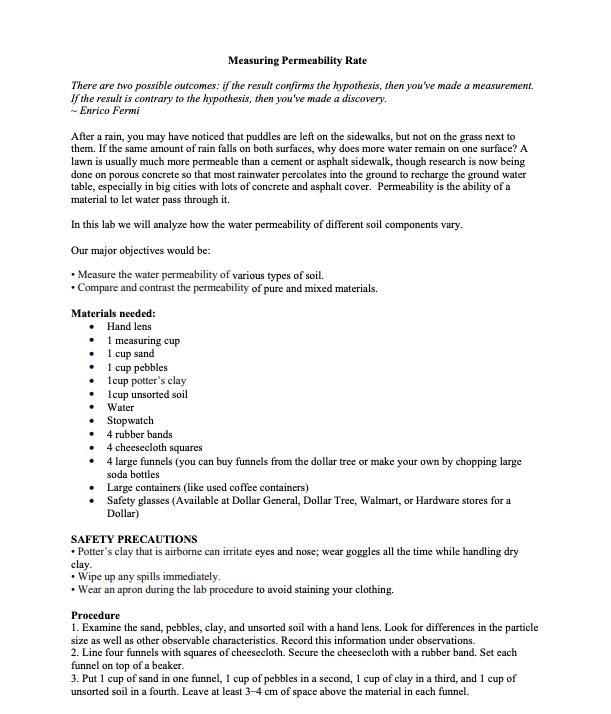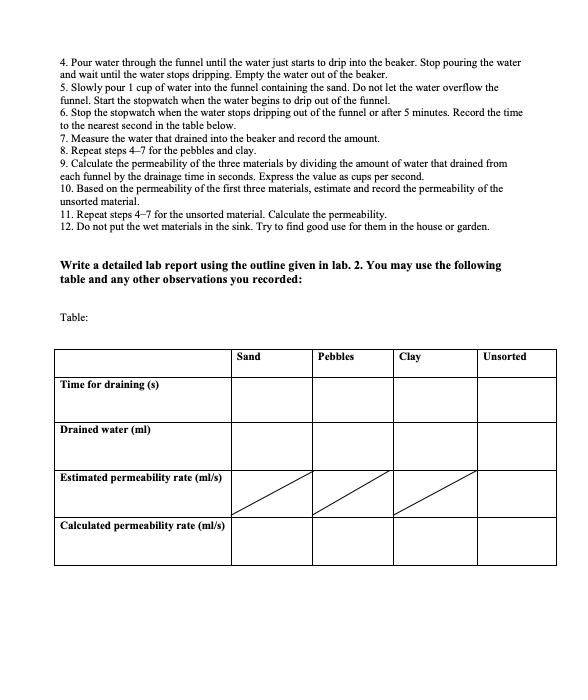Answered step by step
Verified Expert Solution
Question
1 Approved Answer
Measuring Permeability Rate There are two possible outcomes: if the result confirms the hypothesis, then you've made a measurement. If the result is contrary


Measuring Permeability Rate There are two possible outcomes: if the result confirms the hypothesis, then you've made a measurement. If the result is contrary to the hypothesis, then you 've made a discovery. - Enrico Fermi After a rain, you may have noticed that puddles are left on the sidewalks, but not on the grass next to them. If the same amount of rain falls on both surfaces, why does more water remain on one surface? A lawn is usually much more permeable than a cement or asphalt sidewalk, though research is now being done on porous concrete so that most rainwater percolates into the ground to recharge the ground water table, especially in big cities with lots of concrete and asphalt cover. Permeability is the ability of a material to let water pass through it. In this lab we will analyze how the water permeability of different soil components vary. Our major objectives would be: Measure the water permeability of various types of soil. Compare and contrast the permeability of pure and mixed materials. Materials needed: Hand lens 1 measuring cup 1 cup sand 1 cup pebbles lcup potter's clay lcup unsorted soil Water Stopwatch 4 rubber bands 4 cheesecloth squares 4 large funnels (you can buy funnels from the dollar tree or make your own by chopping large soda bottles Large containers (like used coffee containers) Safety glasses (Available at Dollar General, Dollar Tree, Walmart, or Hardware stores for a Dollar) SAFETY PRECAUTIONS Potter's clay that is airborne can irritate eyes and nose; wear goggles all the time while handling dry clay. Wipe up any spills immediately. Wear an apron during the lab procedure to avoid staining your clothing. Procedure 1. Examine the sand, pebbles, clay, and unsorted soil with a hand lens. Look for differences in the particle size as well as other observable characteristics. Record this information under observations. 2. Line four funnels with squares of cheesecloth. Secure the cheesecloth with a rubber band. Set each funnel on top of a beaker. 3. Put 1 cup of sand in one funnel, 1 cup of pebbles in a second, 1 cup of clay in a third, and 1 unsorted soil in a fourth. Leave at least 3-4 cm of space above the material in each funnel. cup of 4. Pour water through the funnel until the water just starts to drip into the beaker. Stop pouring the water and wait until the water stops dripping. Empty the water out of the beaker. 5. Slowly pour I cup of water into the funnel containing the sand. Do not let the water overflow the funnel. Start the stopwatch when the water begins to drip out of the funnel. 6. Stop the stopwatch when the water stops dripping out of the funnel or after 5 minutes. Record the time to the nearest second in the table below. 7. Measure the water that drained into the beaker and record the amount. 8. Repeat steps 4-7 for the pebbles and clay. 9. Calculate the permeability of the three materials by dividing the amount of water that drained from each funnel by the drainage time in seconds. Express the value as cups per second. 10. Based on the permeability of the first three materials, estimate and record the permeability of the unsorted material. 11. Repcat steps 4-7 for the unsorted material. Calculate the permeability. 12. Do not put the wet materials in the sink. Try to find good use for them in the house or garden. Write a detailed lab report using the outline given in lab. 2. You may use the following table and any other observations you recorded: Table: Sand Pebbles Clay Unsorted Time for draining (s) Drained water (ml) Estimated permeability rate (ml/s) Caleulated permeability rate (ml/s)
Step by Step Solution
★★★★★
3.34 Rating (145 Votes )
There are 3 Steps involved in it
Step: 1
Sand Pebbles Clay Unsorted ...
Get Instant Access to Expert-Tailored Solutions
See step-by-step solutions with expert insights and AI powered tools for academic success
Step: 2

Step: 3

Ace Your Homework with AI
Get the answers you need in no time with our AI-driven, step-by-step assistance
Get Started


